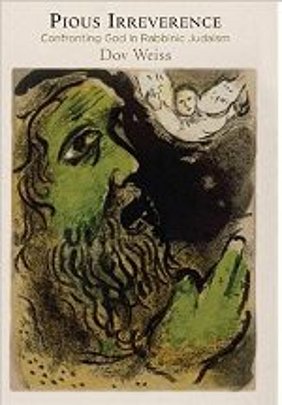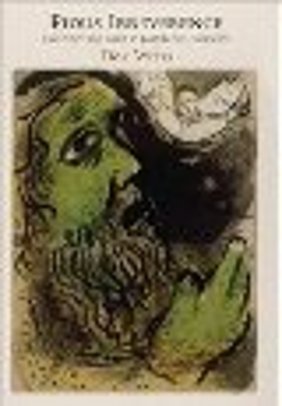The subject of this work is the attitude of rabbinic Judaism toward the act of confronting God. In the narrowest sense, this confrontation consists of an argument with God, charging God that he does not behave the way that ethical humans expect him to act. This confrontation may conclude with the acceptance of the idea that the ways of God are inscrutable but it may include a demand that God act in the way that humans expect him to act. The irreverence is clear; the piety is in the fact that the confronter recognizes the existence of God, although a seemingly immoral God, and does not use the injustice found in the world to deny God's existence. Dov Weiss uses the term "protest" to describe this type of confrontation. However, in his discussion of pious irreverence, Weiss includes the act of Honi hame'agel, who uses his close relationship with God to force God to do his will. This might be considered "pious irreverence," but it is difficult, although not impossible, to consider Honi as a protester.
There are two theses in this work: one historical and one theological. The historical thesis is that, although the Hebrew Bible presents a number of examples of such confrontation, this type of confrontation does not appear in rabbinic literature in the period between the destruction of the Second Temple (69-70 CE) and the third century CE. Indeed, some rabbinic sources from this period consider protest against the actions of God as a sinful act. The author is satisfied with presenting the theories of Abraham Heschel and Arthur Marmorstein for this historical change and does not suggest anything new.
Protest reappears in the Babylonian Talmud and reaches full intensity in the literature known as the Tanhuma-Yelamdenu midrashim. (The author devotes several pages to discuss the relationship between the Babylonian Talmud and these midrashim.) There are anti-protest sources in this period that stress the punishment meted to protesters. The author suggests that the severity of the punishment is a response to the existence of protest. Weiss provides several reasons for the reappearance of protest but he describes these possibilities as speculation.
The theological thesis relates to the image of God that is held by the protesters, mainly those of the Tanhuma-Yelamdenu midrashim. The anti-protest camp simply assumes that God is infallible. They may have an ethical problem but their conception of God is simple. However, those who "protest" must maintain a different conception of God. Weiss suggests that these protesters "humanize" God. Weiss points out that in this midrashic literature we find some rabbis thinking that God is fallible and that he may actually learn ethics from his creatures. This is more than anthropomorphism which creates God in the physical image of man: "humanizing" looks at God as the emotional equivalent of man. The story of Honi is relevant in this context because, although Honi is not presented as a protester, he certainly humanizes God as a doting father. Honi's statement to God that he will not move from his place until God does what he wants is the equivalent of a child threatening a parent that he will hold his breath until the parent gives in. In a section that serves as an excursus, Weiss contrasts Urbach's understanding of the rabbis with that of Moshe Idel and Michael Fishbane. Ephraim Urbach described the rabbis as rationalists who thought of God as a transcendent being. Therefore, their anthropomorphic descriptions should be considered as "rhetorical concessions" to the simple audience. Opposed to this are Idel and Fishbane who designate the rabbis "as mythmakers rather than philosophers" who conceived of God as "an evolving, mythical and corporeal deity who is a player in the world's event rather than merely a determiner" (p. 153).
The book is organized in a straightforward manner. There is an introduction that includes introductory material but also presents a summary of the work and its conclusions. The first chapter, "Confrontation as Sin," presents sources that are anti-protest. In accordance with the author's thesis, one would expect this chapter to deal with the tannaitic material. However, the chapter includes anti-protest material from later sources and even includes anti-protest material from Christian writers. This wide spectrum tends to dull the emphasis on the uniqueness of tannaitic material, which includes only anti-protest attitudes.
The title of the second chapter, "From Sin to Virtue," emphasizes the historical aspect, implying that what was once considered a sin, protesting God, has later become a virtue. However, due to the broad scope of the first chapter, the historical element is somewhat blunted. The author begins by describing two later midrashim that present protest and discusses the reworking of older anti-protest traditions to include a measure of protest. He then debates with David Kraemer about the reasons for the reappearance of protest. One of the author's suggestions is that protest is related to the concept of parresia (speaking freely). This concept refers to the right and duty of philosophers and later, Christian church leaders, to reprove the temporal rulers when they thought that the rulers had acted improperly. This fits in well with the author's thesis about "humanizing" God. The author goes farther and suggests that "humanizing" God let the rabbis think of God as a friend and the Tora requires one to reprove a friend when necessary.
The third chapter, "Varieties of Confrontation," discusses the rhetorical devices used in protest. The rabbis were careful not to confront God directly. Rather they put their protests in the mouths of biblical figures and angels. They distinguished between legitimate protest, such as that of Abraham, and illegitimate protest, such as that of Job. Protest could also be legitimized if it were done for someone else's sake and not for the benefit of the protester. At times, the form of the protest could give it legitimacy. If it were presented as a prayer, the piety of prayer could legitimize the irreverence of the protest.
The fourth chapter, "Confrontation as Ethics," suggests that the motivation of protest is conflict between the actions of God and ethical sensibilities. The chapter ends with an extensive survey of ethical critiques of God in non-rabbinic literature. The survey covers material from the second century to the ninth century. Its relevance to the main thesis is tangential. Most of the works surveyed present the critiques as reasons for rejecting the Hebrew Bible and its God. Christian sources that bring up the critiques do so only to respond to them and explain why God is always right.
The fifth chapter, "The Humanization of God," presents the idea, already discussed above, that the rabbis developed a concept of God that enabled them to think that criticizing him is not only legitimate but also a worthy endeavor. The sixth chapter, "Divine Concessions," continues the idea of humanizing by presenting examples of cases in which God recognized the legitimacy of the protesters and acquiesced to their claims. The conclusion is mostly devoted to contrasting rabbinic confrontation with God, as developed in the book, with "theological protest in other religious traditions" (p. 183). "Other traditions" in this context refers to Christianity and the author offers several ideas about why protest did not develop in Christianity.
An index of rabbinic sources would have made a great improvement in the book. The author does not cite all the examples for each phenomenon that he examines. A student of a particular passage in the midrash would like to know whether this has been discussed in the book. Without an index, this is difficult. But there is another reason that an index is so important. The main discussion of irreverent piety is based on Tanhuma-Yelamdenu midrashim. It is important to the author's argument to know the extent of these midrashim that are cited and how much of other rabbinic material has been cited as a counterfoil to the Tanhuma-Yelamdenu midrashim.
I found only one printing error in the book but the error is somewhat confusing. The book says that "God binds Isaac" and it took me a moment of reflection to realize that it should read "God blinds Isaac" (p. 53). There are several instances in the bibliography where entries do not begin a new line (see De Roche, Fleisher).
In summary, Weiss presents an interesting and challenging thesis that is based on great erudition. He is aware that other explanations may exist for the phenomena that he presents. The lack of criticism in tannaitic literature may be due to the dearth of aggadic material in this literature and the humanizing of God in the midrashim may be a rhetoric concession to the audience for which this material was intended. He offers reasoned arguments for accepting his explanation of the sources. His book will be read with profit and interest by scholars and laymen alike.



